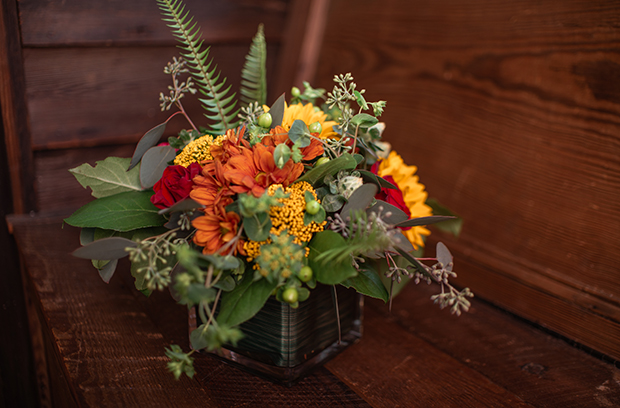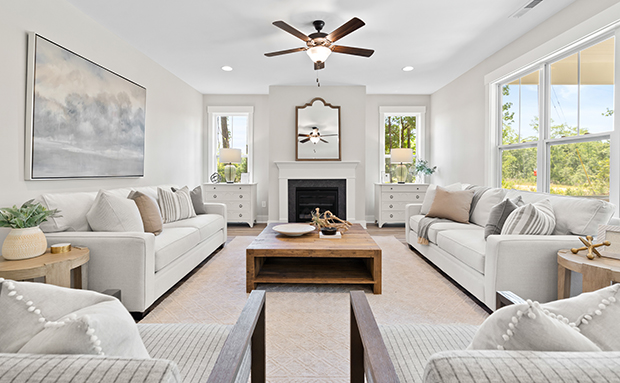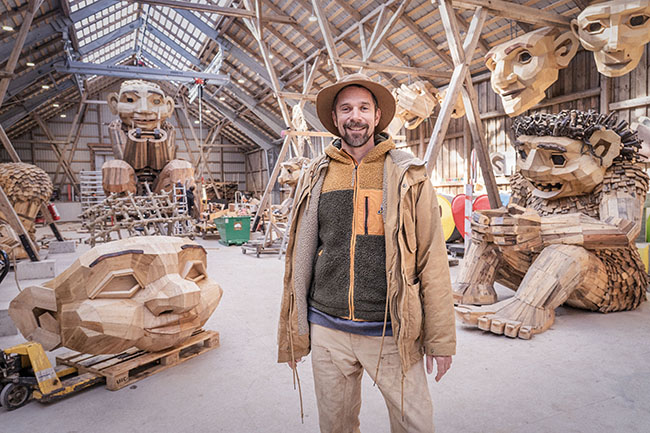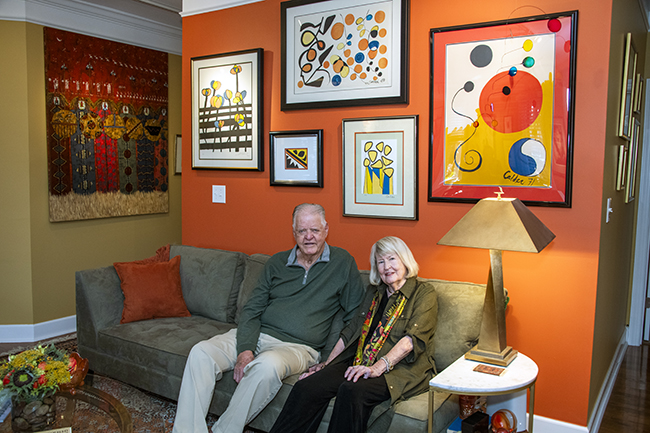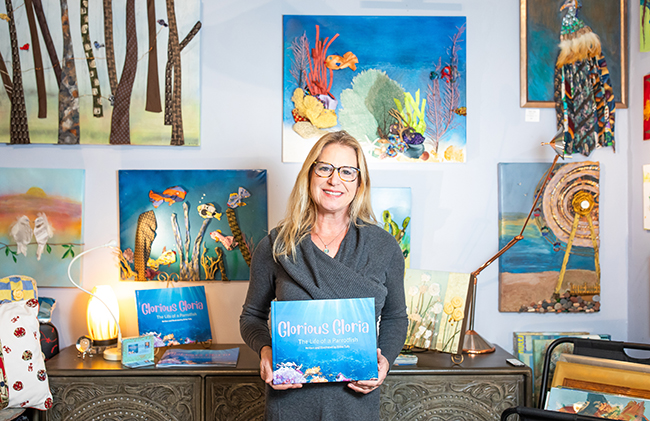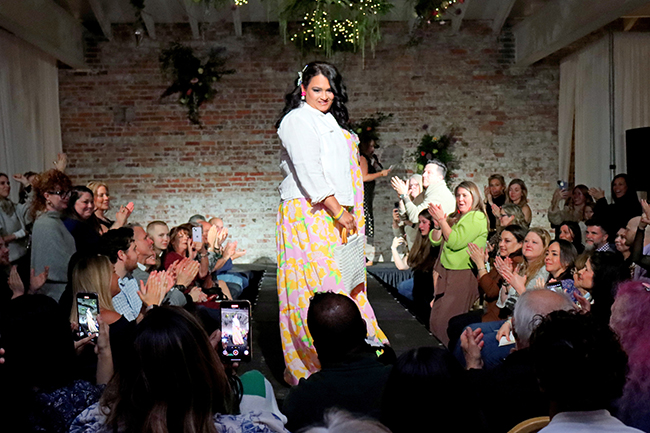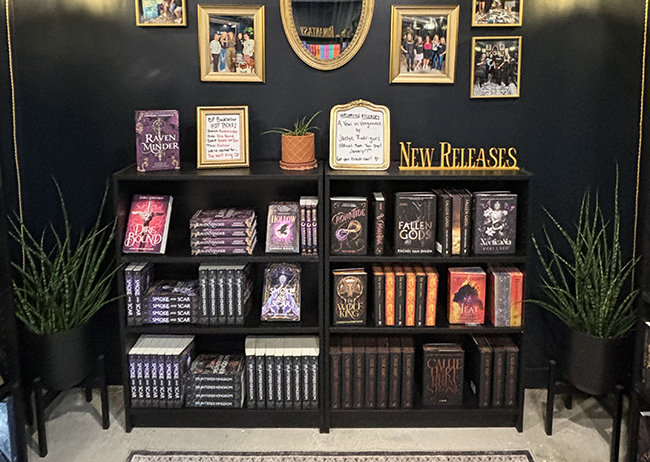60 Years of Art, Community and Love
02 Nov 2022
Passion and dedication interweave CAM’s six decades as a regional arts center
By Heather Wilson » Photos by Alan Cradick
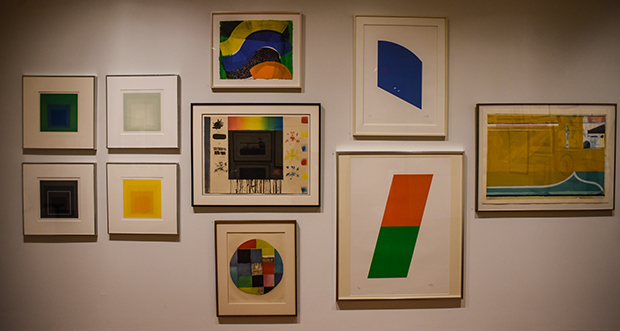
The story of Cameron Art Museum has been described as a love story: the love of Bruce Barclay Cameron, Jr. for his late wife Louise, the love of citizens for their community, the story of a group of people bound by their common love of art, the love of friends for one another.
Every story has its beginning and Cameron Art Museum’s could start here: Elisabeth Chant, long auburn hair coiled around her head, arrived in Wilmington in late 1922 carrying a trunk of belongings and art supplies. Chant, an eccentric British artist who imagined herself a descendant of King Arthur, set up an art studio on Cottage Lane, in the Hart Wine House, where students like Claude Howell and Henry Jay MacMillan took art classes. One young man rode his pony, Rosco, to take her classes. That young man was Bruce Barclay Cameron, Jr. Perhaps the roots of Cameron Art Museum were laid there on Cottage Lane, among the tang of turpentine and the dust of charcoal, the creativity and passion of youth, the city’s only Druid presiding.
Chant was passionate about the need for a civic art center, and she wrote to the Wilmington Star News on July 17, 1938, “In the life of cities a time comes for cultural development. The drama, music, art, each in turn filling a place in the civic fabric. A movement has been launched to give Wilmington a civic art center with a museum and gallery. It will mean: Wider horizons for the young. New interests for the mature. For visitors and tourists, a place of intellectual enjoyment . . . Next to its educational importance an authoritative museum center is badly needed in Wilmington to conserve the aesthetic values of this city. . .In no other way will it be done.” Chant was part of a group of citizens that founded the Wilmington Museum of Art, which was open from 1938-1942. The museum closed because of World War II and rising property costs, but its brief existence and the 126,213 visitors and 71 exhibitions reminded the community what was possible. Chant stayed in Wilmington, teaching and painting, until her death in 1947. She is buried in Oakdale Cemetery.
Forty years after Chant’s arrival, at least three of her students and colleagues, Claude Howell, Hester Donnelly, and Peggy Hall, were part of the community movement that founded St. John’s Art Gallery in the oldest Masonic Lodge in the state. Claude Howell, who was then chair of the University of North Carolina Wilmington art department, wrote in a letter to the editor of the Wilmington Star News on January 28, 1962, “…we need to see and hear the best that is being done in the world today. We need to raise our standards in the visual arts by showing the best art of the past, as well as what is being produced today. The best way in which this can be done is for Wilmington to establish a community gallery or museum, not so much for the purpose of buying a permanent collection, but for the express purpose of exhibiting traveling shows of first-rate painting and sculpture. . .Only by becoming familiar with the best can we hope to improve our level of appreciation.”
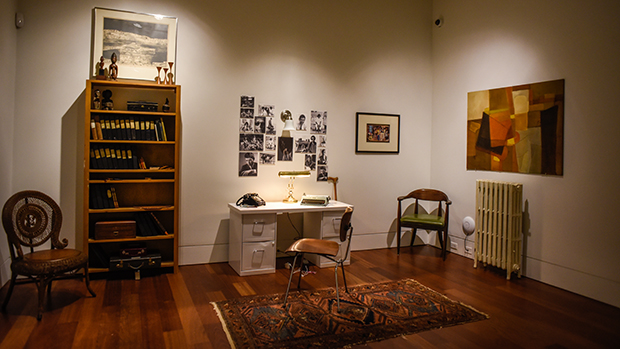
Hall became St. John’s first paid director in 1964. In that very first year St. John’s presented 24 exhibitions, 15 preview receptions, 11 lectures, 7 chamber music programs, and 1 trip to the North Carolina Museum of Art. Attendance in the 4,705-square-foot building in downtown Wilmington reached 12,000 people in the first year, with visitors from 10 foreign countries and 181 different cities in North Carolina. St. John’s opened with an exhibition by contemporary realist Francis Speight, who had been born in Bertie County and taught at East Carolina University. The museum’s core values, which remain 60 years later, were evident from the beginning: commitment to community, to lifelong learning in the arts, to support of artists, and to collecting, preserving, documenting, and interpreting a permanent collection of art.
Henry Jay MacMillan, another student of Chant’s, served in the U.S. Army as a combat artist in North Africa, Sicily, Normandy, Belgium, Holland, and Germany. While studying in New York after high school he met Samuel Hudson Hughes, and they became fast friends. MacMillan invited Hughes to Wilmington on holidays, and Hughes became friends with MacMillan’s friends, including the Cameron family, Claude Howell, and Louis Belden. Like the seminal arrival of Chant in 1922, this friendship is crucial to the story of the museum and to the future of Cameron Art Museum. Hughes became an architect and an interior designer in New York, but he continued to visit Wilmington. In 1967, after he retired, he moved permanently to Wilmington and devoted himself to St. John’s. An article from the time in the Star News calls St. John’s Hughes’s “pet project.”
In 1972 St. John’s Art Gallery became St. John’s Museum of Art. If the founders of St. John’s had done a feasibility study before creating a museum, they would have likely been told that funding an art museum without an umbrella institution like a city, county, or university was not advisable, but they were unburdened by that knowledge, and instead the momentum was contagious, their ambition boundless. The community’s love of the arts, its ambition for an art museum, and the relationships that this common desire ignited buoyed St. John’s.
The volunteer force at St. John’s was unrivaled. A brief glance at Board minutes and old newsletters, shows volunteers busy working on the grounds, hosting fundraisers, modeling in fashion shows (this was a big thing in the 1980s), and giving tours. The volunteer roster is a who’s who of Wilmington society, and St. John’s was known for its parties, its exhibitions, its fellowship. Volunteers included Hilda Godwin, who was at the head of every fundraising effort, Rebecca Laymon Ficklen, who chaired the Board during the campaign to build the new museum, and Louise Wells Cameron, who married Chant’s student Bruce Barclay Cameron, Jr. in 1948 and who organized floral displays and opening parties.
Sam Hughes secured donations from Rachel Cameron Fox Camp and Hilda Cameron Echols to renovate St. Nicholas Greek Orthodox Church and helped with fundraising to purchase the Cowan House and expand St. John’s in 1979. The museum grew – from one building to three -- and its collection grew too. The first acquisition in 1964 was Portrait of a Gentleman, an oil painting from 1824 by Jacob Marling (American, 1744-1833), a gift of Mr. and Mrs. James E. Hall of Lumberton. Marling had been the first director of the North Carolina Museum in 1813. A painter and a teacher, Marling was also an art collector.
In 1966, St. John’s received 83 pieces of Jugtown Pottery as a gift of Woodrow W. Pruett and William Bridges in memory of Juliana Royster Busbee. This was followed by the gifts of two works by Minnie Evans by the artist herself in 1970. In 1972, Henry Jay MacMillan and Hester Donnelly gave 104 works by their teacher Elisabeth Chant to St. John’s. The trunk Chant carried when she arrived in Wilmington and its contents were also given to St. John’s. The identity of the museum and the core of its collection of North Carolina art began to be forged. Sam Hughes turned his interest to collecting as well, purchasing art for his own collection (which he would leave to the museum), purchasing art for the museum’s collection, and persuading former clients to donate their art to the museum.
In 1984, Hughes encouraged his friend and former client Therese Thorne McLane of Millbrook, New York, and Southern Pines, N.C., to donate The Ten, a series of Impressionist prints by American artist Mary Cassatt that he encouraged her to purchase in the 1930s, to St. John’s. The works in the series are dated 1891-1897, and they depict domestic life of the late 1800s from a distinctly female gaze. Cassatt, an ardent supporter of women’s rights, was one of few women who exhibited with the Impressionists. The prints draw inspiration from the color palate of Japanese woodblock prints. At the time of donation, the prints were insured at a value of over $2 million.
In 1995, Dr. Isabel Bittinger of Winston-Salem, N.C., presented a gift of 108 Japanese ukiyo-e color woodblock prints to St. John’s Museum of Art. The prints were bound in an album and included two series: Tõkaidõ gojusan-tsugi (Fifty-three stations of the Tõkaidõ) by Andõ Hiroshige and Genji Monogatari (The Tale of Genji), attributed to Utagawa Kunisada II. Bittinger, the first female orthopedic surgeon in North Carolina, had met Claude Howell, who introduced her to St. John’s and encouraged her to consider St. John’s as a place to donate her collection.
These prints had remained in Dr. Bittinger’s family and were originally owned by Reverend Edmund Bittinger, a Presbyterian chaplain who traveled with Commodore Matthew Perry aboard the Susquehanna, on the 1853-54 U.S. naval entry into Japan. According to family tradition, Reverend Bittinger received the album of prints as a gift from the Japanese government during the voyage. They had remained in storage in the intervening years, accounting for the well-preserved condition and brilliant color of the prints, the colors that had inspired Impressionists like Cassatt.
As the museum’s collection grew, so did its focus. In 1992, the acquisitions committee rewrote their policy stating, “St. John’s Museum of Art’s primary focus is collecting 19th and 20th century North Carolina art. In addition, the Museum collects American art to put the North Carolina collection in a broader context.”
Growth Prompts Expansion & Core Vision
In 1997, the community of St. John’s found itself at a crossroads – it had outgrown the cluster of historic buildings in downtown Wilmington and now started a capital campaign to build a new modern art museum. At the helm of the museum was C. Reynolds “Ren” Brown, a director who saw the new museum not only as a community museum, but as a statewide resource. Charles Gwathmey, a New York architect who spent the first 18 summers of his life at Wrightsville Beach and who had been a lifelong friend of Claude Howell was chosen as the architect for the new museum. Claude Howell credited Gwathmey’s father, artist Robert Gwathmey, as one of his major influences. One of Gwathmey’s most noted achievements was the renovation and addition to the Solomon R. Guggenheim Museum in New York.
Bruce Barclay Cameron, Jr., one of the great civic leaders at the time, made a lasting impact on the arts community in Wilmington, by donating $4.5 million to help build a new art museum, inspired by his late wife Louise’s love of St. John’s, where she volunteered for 35 years. The children of Bruce Barclay Cameron, Jr. offered 9+ acres of land to the museum, located at the corner of S. 17th and Independence Avenue, with a provision that Civil War Historic site and long-leaf pine trees on the site be preserved. The museum was named Louise Wells Cameron Art Museum in her memory. As Cameron said to the Star News in 2002, “When Louise, my wife, died…I wanted to do something in her memory. She loved St. John’s so much.”
In 2002 the museum moved to South 17th Street and became Louise Wells Cameron Art Museum. A year later, Walter and Beth Pancoe made the single largest gift to a new auxiliary building for art classes, and the Pancoe Arts Education Center, now home of the Museum School, was established.
In the summer of 2004, two short years after the opening of Louise Wells Cameron Art Museum (CAM), longtime Director Ren Brown passed away after a battle with cancer, devastating the staff, Board, volunteers, and members. The museum began a year-long search for a new director and hired Deborah Velders. Velders came to CAM after 15 years as the head of exhibitions and public programs for the Menil Collection in Houston. As Director and Chief Curator for CAM she launched a successful endowment campaign, which raised $5.7 million. She was known for the creativity of high-profile exhibitions that she curated during her tenure, including Between Taste and Travesty: The Costume Designs of William Ivey Long. During Velders’s tenure, the museum hired ceramist Hiroshi Sueyoshi as an artist-in-residence and launched Connections, a program for anyone living with Alzheimer’s or dementia.
Velders stayed at the museum for five years, after which the museum hired long-time curator and Assistant Director Anne Brennan as Executive Director.
All this time, Louis Belden, one of Sam Hughes’s longtime friends, continued to add to his collection of postwar modernist and postmodernist prints, a collection inspired and influenced deeply by his relationship to Sam. Belden, who lived in New York and San Francisco as an adult, had grown up in Indiana, but he spent his summers in Wilmington, where he met Sam Hughes and the Cameron family. Although he frequented major art museums in San Francisco, Belden wanted to give his collection to a museum where he knew it would truly make a difference. Belden was a serious collector, dedicated to not only to acquiring an exceptional collection, but also to growing and challenging himself as a collector. The friendship between Belden and Hughes, who had met as young men, was echoed in Belden’s collection; Belden took a break from collecting only in the late 1990s, after his dear friend died in 1992.
In 2017, Belden bequeathed his art collection, the gift of his lifetime, to the CAM community. This unprecedented gifts of 136 works by 54 artists elevated CAM’s collection and included American and European artists Josef Albers, Marc Chagall, Alexander Calder, Judy Chicago, Helen Frankenthaler, Jasper Johns, Ellsworth Kelly, Pablo Picasso, and Robert Rauchenberg. These works offer a range of expressionism, experimentalism, and expansion of the terrain of postwar modernism and post-modernism. It’s an incredible gift, one that likely would have never happened without Sam Hughes, without Henry Jay MacMillan, without the Cameron family, perhaps without Elisabeth Chant and her classes on Cottage Lane.
Louis Belden’s gift to CAM extended the museum’s commitment to works on paper, as begun with the donation of the Cassatts and continued with the Japanese woodblock prints. Belden’s gift deepened the museum’s collection in exciting and surprising ways, opening doors for scholarship, research, programming, and additional collecting.
Over the last decade, the museum continued to thrive. Without regular city, state, or federal funding, the community created an art museum that has lasted for 60 years and that has become one of the most respected cultural resources in the state. Under the leadership of Anne Brennan, CAM’s collection has expanded to include diverse contemporary artists with North Carolina ties that also contribute to the growing understanding of American art to include Romare Bearden, Beverly Buchanan, Beverly McIver, Lien Truong, Michele Tejuola Turner, and Burk Uzzle. The collection, which started in 1964, with a work by Jacob Marling, now stands at 3300 works, with a growing focus on modern art.
Brennan’s vision for the museum is expansive and inclusive. She has raised CAM’s relevance to the entire community, reaching out through the work of the Board-led education committee to the Wilmington Housing Authority, New Hanover County Schools, the Resiliency Task Force, and Cape Fear Latinos, among other community organizations. During her tenure, the museum’s governing Board, its staff, and volunteers have diversified, reflecting the vitality of the surrounding community, which welcomes retirees from across the country. CAM’s current Board Chair, Gregory Miller, previously served on the Board of the Barnes Foundation in Philadelphia and that national perspective helps the museum to maintain relevance. Through Brennan’s leadership Compass, a giving society dedicated to collecting, which allows members votes for acquisitions to the permanent collection, continues to grow the permanent collection and educate members and the public. CAM serves over 60,000 visitors each year; 8,000 of those visitors are children.
In 2021, CAM installed a public sculpture, Boundless, by North Carolina artist Stephen Hayes, a work of art that connects deeply to the land the museum is steward of by telling the story of the brave United States Colored Troops soldiers who fought on this land for their own freedom and the freedom of their loved ones. Z. Smith Reynolds Foundation provided the seed money for the project, and major sponsorship was provided by PNC Bank. Carol Miller, wife of Board Chair Gregory Miller, led a committee that sold raffle tickets, sold pavers, presented a telethon, and hosted an event to raise money for the sculpture. Perhaps even more importantly, this committee, like the passionate citizens who founded St. John’s, brought the story of CAM’s work to their churches, civic groups, sororities, fraternities, friends, and family, kindling a new fire for the work of the museum in the area. Boundless brought national attention to this community-led museum and CAM was featured in The New York Times, The Washington Post, Essence, and The Daily Beast. CAM received a grant from the Institute of Museum and Library Services to hire a Cultural Curator, a young historian named Daniel Jones, who had worked previously at the Wrightsville Beach Museum, the Burgwin Wright House, and the Wilmington Railroad Museum, to use art to address social justice issues.
At it celebrates its 60th anniversary, Cameron Art Museum continues to show the truth in what collector Louis Belden fervently believed and practiced, “Art is not stagnant. It grows and grows. To learn, you work at it with your eyes and your mind. And your heart.” cameronartmuseum.org
Heather Wilson is the Deputy Director Of Cameron Art Museum.

